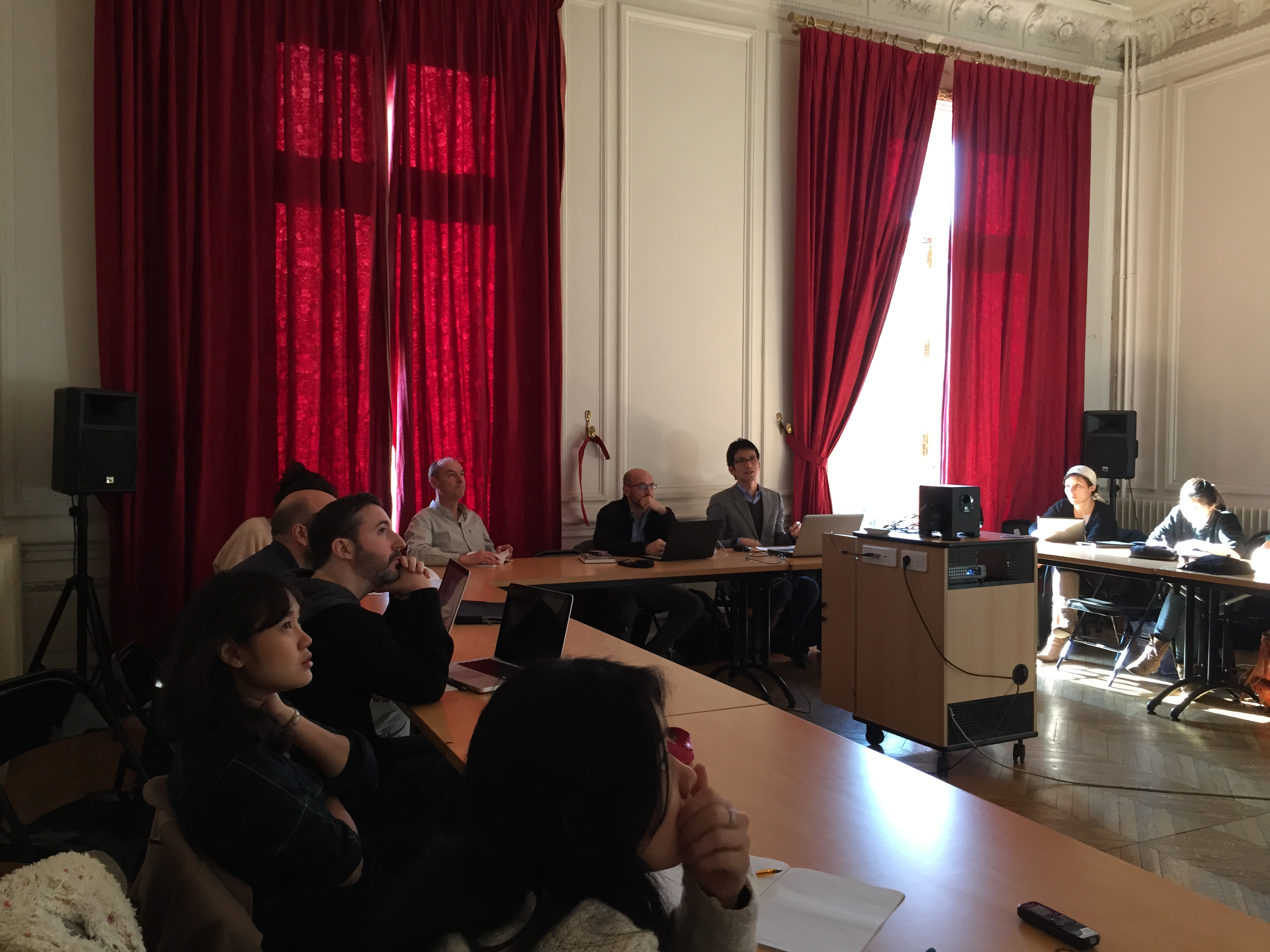2015.02.05
CASE セミナー Seminar at CASE
2015年2月5日、フランスの東南アジアセンター (Centre Asie du Sud-Est) がほぼ毎週開催する定例セミナーで、本プロジェクトのメンバーである太田淳(広島大学)が以下の報告を行った。パリ中心部にあるMaison de l'Asie という建物で開催されたそのセミナーには、CASEおよびEHESS(フランス社会科学高等研究院)内のその他の機関の研究員および大学院生を中心に、10数名が参加した。
Atsushi Ota, “Social Transformation of Early-Modern Banten, West Java: Internal Move to Modernity”
本報告は、18世紀後半における西ジャワ・バンテン社会の変容を検討した。冒頭で太田は、従来のバンテン王国の研究が1682年にスルタンがオランダ東インド会社の強い影響下に置かれる以前の時代に集中していること、また港市を中心とする海岸部に関心が集まり内陸部がほとんど無視されてきたことを説明した。これに対して本報告は、18世紀後半から東南アジア各地は中国貿易の活発化によって多くの経済的機会に接触するようになっており、バンテンも例外ではなかったことを主張した。その例として、バンテン内陸部の地域エリートが胡椒栽培の拡大を通じて影響力を拡大したことや、一般の農民も外部商人との取引を通じて中国貿易に参加していたことを取り上げた。そしてこのように地域住民が市場志向性を強めていたことが、いわば下からのグローバル化、近代化であったと結論づけた。
この報告に対してフロアからは、「近代」の捉え方に関する質問が多く出された。16世紀以来外部との貿易が活発であったバンテンで、なぜこの時期の貿易や住民の対応が近代的であると言えるのか、どこが16-17世紀の事情と違うのかが質問された。さらに、生産者が対価を求める行動は人間の歴史において常に存在するのではないかという指摘もなされた。これに対して太田は以下のように回答した。16-17世紀の輸出品は、東南アジアでは一般に高級香料や香木など奢侈品が主力であり、王がその生産や流通を独占することが多かったが、18世紀に輸出の重心はより安価ではあるが中国の中産階級にとってやや贅沢で購買意欲を刺激される海産物(ナマコ、フカヒレなど)、森林産物(籐など)、燕の巣などに移った。こうした産品は王の独占が困難で多くの生産者や商人が関与することになり、住民の市場志向化が進んだ。また17世紀までは農民が胡椒の対価として輸入綿布を求めたとの記録があるのに対し、18世紀後半では常に銀貨を求め僅かな価格差にも敏感であったこと、さらに現金収入を求めて人々が移住するようになったことも、市場志向化が進んだことの現れであろう。この他にインドネシア地域社会の専門家から、イスラームの浸透の程度や土着信仰との混淆について質問が出された。このような質問に続く議論は、グローバル化を経済の視点からのみ論じるのではなく、論点を多角化する必要性を感じさせるものとなった。
(文責:太田淳)
On February 5, 2015, Atsushi Ota (Hiroshima University), who is a member of this project (GHC), gave the following report at the regular weekly seminar hosted by the Centre Asie du Sud-Est (CASE) in France. The seminar, held in a building called the Maison de l’Asie in the center of Paris, was attended by a dozen or so researchers from CASE, EHESS (École des hautes études en sciences sociales), other institutions, as well as graduate students.
OTA Atsushi: “Social Transformation of Early-Modern Banten, West Java: Internal Move to Modernity”
In his presentation, Atsushi Ota examined the transformation of Banten society in West Java in the latter half of the 18th century. Ota began by explaining that research up to this point on the Banten Sultanate focuses on the period before 1682 when the sultanate came under the influence of the Dutch East India Company and focuses on the port city and coastal areas while largely ignoring inland areas. In contrast, Ota argued that, in the latter half of the 18th century, the entire Southeast Asian region enjoyed numerous economic opportunities thanks to increased activity of Chinese trade, and that Banten was no exception. To illustrate this point, Ota explained how the local elite of inland areas of Banten expanded their influence through expansion of pepper production and how local farmers participated in Chinese trade through transactions with external merchants. Ota went on to conclude that this strengthening of the local residents’ market orientation comprised a bottom-up globalization and modernization.
In response, numerous questions were raised by the audience regarding the definition of “modernization,” including why the trade and residents’ response in the 18th century could be called “modernization,” given that Banten had been engaged in vigorous external trade since the 16th century and what circumstances in the 18th century differed from those in the 16th and 17th centuries. It was further pointed out that the activities of producers seeking compensation have existed throughout human history. Ota responded to these questions and comments by explaining that, while the majority of goods exported from Southeast Asia in the 16th and 17th century were luxury items such as high-value spices and sandalwood whose production and distribution was, in most cases, monopolized by the king, in the 18th century, this shifted to marine products (sea cucumber, shark fin, etc.), forest products (rattan, etc.), and swallow’s nests, which were inexpensive but considered luxury items and whet the consumer appetite of China’s middle class. Such goods were difficult for the king to monopolize, and numerous producers and merchants became involved in their trade, strengthening the market-orientation among local residents. Ota went on to explain that, whereas there are records indicating that farmers sought imported cotton in exchange for peppers up to the 17th century, farmers in the latter half of the 18th century consistently sought silver coins and were sensitive to even small price margins and that individuals seeking cash incomes began to migrate. Ota argued that these were also manifestations of the strengthening market-orientation. A question was also raised by a specialist in Indonesian regional community regarding the degree of penetration of Islam and the mixing of Islam with indigenous beliefs. The discussions resulting from questions of this type seemed to drive home the need to discuss globalization from multiple angles and not just from an economic standpoint.
(Atsushi OTA)













